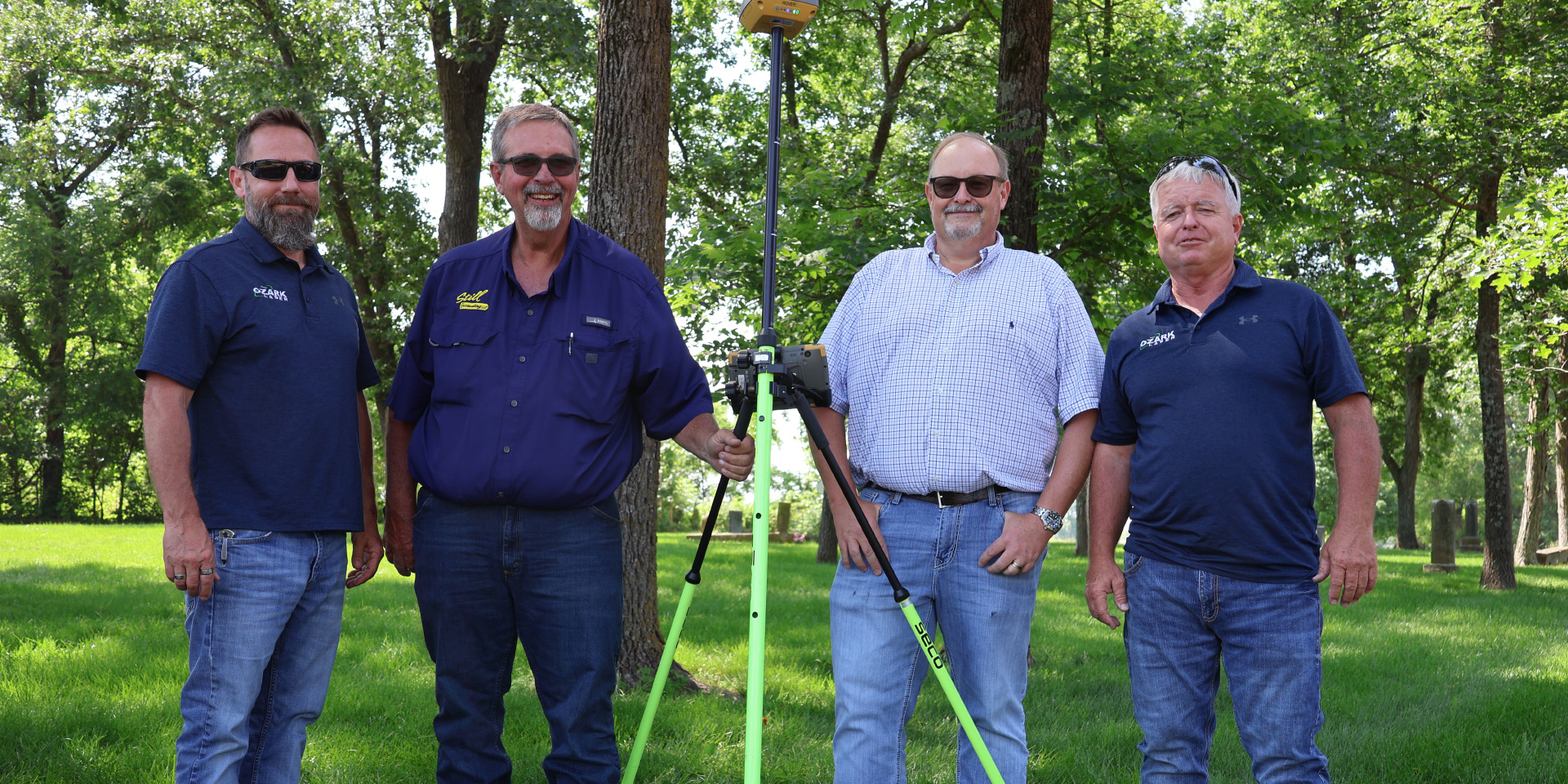Missouri’s state nickname, “The Show-Me State,” infers that Missourians take little at face value, needing, instead, to have things proven to them. While Springfield, Missouri-based excavation specialist, Still Excavating, does not take business matters to that extreme, the company recently had its own “show me” experience when it was looking to improve efficiency on its excavation projects. Already a dedicated user of GPS technology for its staking and layout work, the company, working with equipment dealer Ozark Laser & Shoring, was made aware of the improvements it could realize by automating its excavator. Today, even after projects with some very challenging facets to them, company officials report an uptick in productivity in a steady 25% - 30% range. Consider them “Shown.”
Leading by Example
No stranger to the business at hand, Eric Still has been involved in construction matters since working alongside his father who owned a development/construction firm in the Springfield area in the 1990s. That gave him a taste for the work and steered him toward excavation when the elder Still retired.
“I started with my dad, worked with him for more than 25 years and then, when he retired about five years ago, I went out on my own,” he said. “I have three other brothers and they're all in the building and development business, so it made good sense for me to take care of the excavating end of things. Dad’s company was called ‘Still Construction’ so I named this business ‘Still Excavating’ and, while he would do everything from earthwork to the actual home building, we take work through to the house pad. But that includes all the land clearing, excavation, infrastructure, pad pour — even prep work for the sod to be laid. We offer comprehensive services for both residential and commercial development.”

Still Excavating tackles projects ranging from those that are moderate in scale some as high as $8-10 million, and does so with a staff of roughly 25. “Given the personnel shortages many in the industry are feeling, we are fortunate to have the great team of people we have, and our high retention rate reflects that. But we also make sure to treat them well — we want our people to share in our success.”
“My dad bought that base and rover in 2000 — I think it was the second unit that Ozark Laser sold when they first opened.”
Eric Still
Taking Control

As mentioned, to ensure that their crews could function as efficiently as possible, Still Excavating invested early on in a GNSS-based solution, specifically, a Topcon HiPer Lite receiver, which has since been upgraded several times. That move alone, said Eric Still, streamlined the time- and labor-intensive staking process.
“My dad bought that base and rover in 2000 — I think it was the second unit that Ozark Laser sold when they first opened,” he said. “We were doing a project at Lake of the Ozarks and learned that it could streamline our workflow. At the time, we were having trouble getting people, which really impacted our ability to get staking done on any given project.”
Adding the GPS component to their workflow allowed them to bring the required staking in-house, so to speak. “That, in turn, reduced the time and money spent waiting on an outside surveyor’s availability,” added Still. “We didn’t eliminate surveyors, but it sure did reduce our reliance upon them.”
A Case for Automation
That base/rover solution has continued to serve Still Excavating well. However, always looking for ways to better their customers’ operations, the team at Ozark Laser presented Eric Still with a look at the possibilities automating his excavator could offer.
“Eric does a good deal of design/build work in the Branson, Missouri area — work for which the specs are seemingly always changing,” said Rodney Hunt, Ozark’s machine control trainer. “For a company to succeed in that kind of environment, they must be able to adapt on the fly. We felt that equipping his Case 160 excavator with the newest Topcon MC-Max automation solution would allow them to do that and a whole lot more.”

Hunt’s assessment did not need much time to prove itself, as one of Still’s first jobs to incorporate the new solution offered a range of unique challenges. “At that time, we were working an upscale development on a steep slope at Table Rock Lake in the southern part of the state,” said Still. “It called for us to create multi-level pads for basements, and, doing things in the traditional way, involved constant instrument setup, movement and re-checking. Once we switched to the automated solution, however, we could dig one level, step it down, dig the second, step it down, and so on — it was amazingly fast and accurate. So, those five pads, which would have normally taken us a week or better to do, were done in 2½ days. That definitely sold me on the system.”
“The new TS-i4 sensors allow the operator to know exactly where that machine — particularly the bucket — is at all times.”
Rodney Hunt
Automation Explanation

The solution that so decisively won over Eric Still, Topcon MC-Max Excavator, is designed to maximize the efficiency of the person in the cab, not surprisingly, also one of Still Excavating’s primary goals. Working off the highly versatile MC-X Platform, operators can perform a number of job site functions, including that of surveyor, operator and grade checker. And the platform does so while remaining truly user-friendly and intuitive, according to Cole Rains, one of Still’s foremen and primary operators.
“I literally didn’t have any GPS-type experience at all when I started here, right out of school,” he said. “But, after only a couple hours, I had a real comfort level with the system — it was very easy to learn. And it has been helpful in so many ways. For example, before I got to the position I’m in right now, I had to rely on Eric or another foreman to bring the base and have it there at 7 a.m. when we start work. Because that didn't always happen, I would have to wait for them. With this system, if I have to dig a ditch or excavate for a basement, as long as I know the grade and correct elevation, I can actually run the machine in 2D and still operate it with full automatics. It allows me to stay productive which is good for everyone.”
Ozark’s Rodney Hunt cites the newest generation of IMU sensors as the real key to the MC-X’s ability to perform. “The new TS-i4 sensors allow the operator to know exactly where that machine — particularly the bucket — is at all times,” he said. “So, it provides the ability to reach out, bench and create surfaces on the fly. If an operator, like Cole, is at a pad site and ready to dig but doesn't have a model, as long as he knows how deep he needs to go, he can bench that, enter his offset, and create that pad based upon data from those IMU sensors. No waiting for surveyors, no waiting for a base to arrive, nothing. These sensors make it a whole new ball game for contractors like Eric.”
By anyone’s standards, the improvement Still has seen is impressive. According to Eric Still, they’ve been consistently 25% to 30% faster with machine control than work done without it. “That’s a significant uptick that saves both us and our customers money.”
Quit Your Ditchin’
The advantages provided by the MC-X platform extend to the realm of safety as well. According to Hunt, situations in which it is necessary to put a worker into a ditch with a rover — doing grade checks or gathering as-built data, for example — can be all but eliminated.
“Simply by using the tooth of the bucket, Eric’s crews now have the capability to shoot their as-builts from the cab — MC-X makes that possible, easy, in fact,” said Hunt. “And the safety aspect of that can’t be overstated. I’ve had some of my biggest customers tell me that, anytime you take a man out of the ditch, you are enhancing safety. That’s something of an intangible that people don’t realize, but it’s a huge positive for their operation.”

Still’s satisfaction with the automated excavator solution was so impressive that they recently began testing the system on a larger machine, a Case 300, operating at a project in Rogers, Arkansas.
“I have all the confidence that we will be as satisfied with MC-Max on the 300 as we are with the 160,” he said. “There are so many things that system can do; we are literally just scratching the surface. Even though most of our work is negotiated, when we do bid a job, we can be extremely competitive, knowing that our machine control solutions — we also have Topcon machine control on out Case 1150M dozers — provide a ‘cushion’ that nobody else has. But I like the fact that we are on the cutting edge with this new technology and doing things that not many others can do. In this business, it’s always better to be a leader rather than a follower and it’s kind of nice to be there right now.”

















